Management Economics - Coca Cola
VerifiedAdded on 2023/01/07
|10
|3105
|77
AI Summary
This document discusses the application of management economics principles to analyze the market structure and operations of Coca Cola in the beverage sector. It provides a description of the organization, analyzes the market structure, and explores the characteristics of the previous and current market structure of Coca Cola. It also includes a critical analysis of various market structures and suggests interventions by the government upon key operations of Coca Cola.
Contribute Materials
Your contribution can guide someone’s learning journey. Share your
documents today.
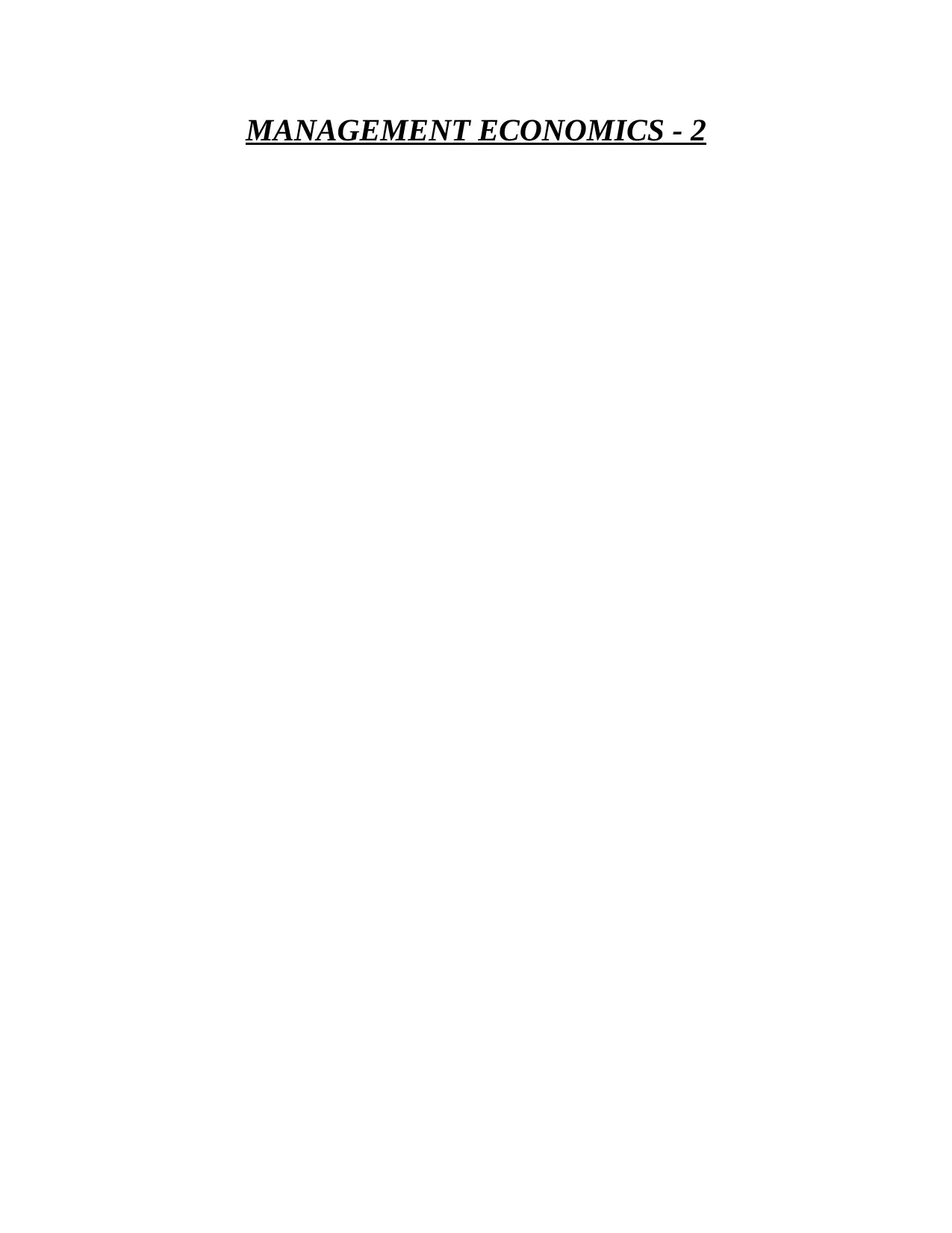
MANAGEMENT ECONOMICS - 2
Secure Best Marks with AI Grader
Need help grading? Try our AI Grader for instant feedback on your assignments.
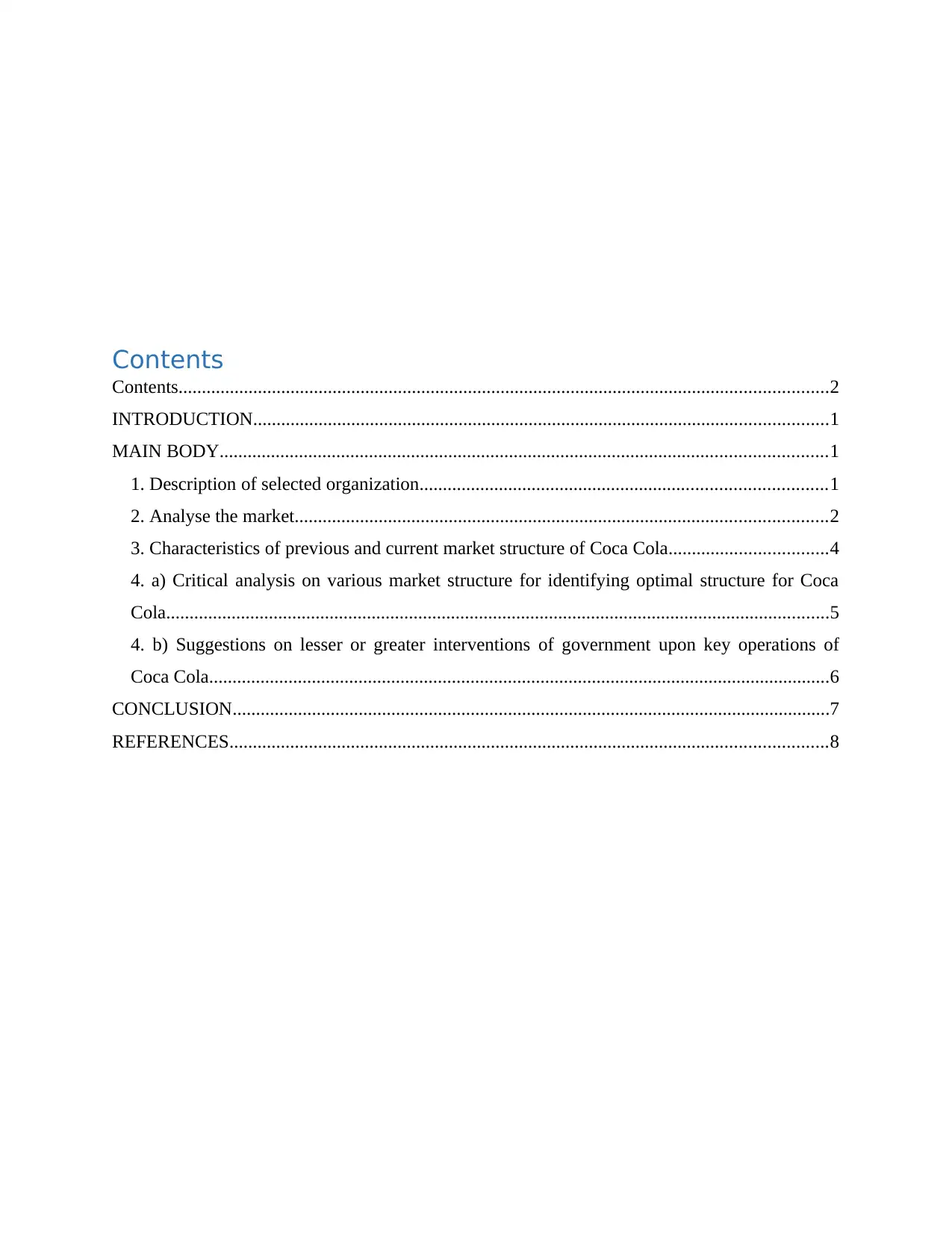
Contents
Contents...........................................................................................................................................2
INTRODUCTION...........................................................................................................................1
MAIN BODY..................................................................................................................................1
1. Description of selected organization.......................................................................................1
2. Analyse the market..................................................................................................................2
3. Characteristics of previous and current market structure of Coca Cola..................................4
4. a) Critical analysis on various market structure for identifying optimal structure for Coca
Cola..............................................................................................................................................5
4. b) Suggestions on lesser or greater interventions of government upon key operations of
Coca Cola.....................................................................................................................................6
CONCLUSION................................................................................................................................7
REFERENCES................................................................................................................................8
Contents...........................................................................................................................................2
INTRODUCTION...........................................................................................................................1
MAIN BODY..................................................................................................................................1
1. Description of selected organization.......................................................................................1
2. Analyse the market..................................................................................................................2
3. Characteristics of previous and current market structure of Coca Cola..................................4
4. a) Critical analysis on various market structure for identifying optimal structure for Coca
Cola..............................................................................................................................................5
4. b) Suggestions on lesser or greater interventions of government upon key operations of
Coca Cola.....................................................................................................................................6
CONCLUSION................................................................................................................................7
REFERENCES................................................................................................................................8
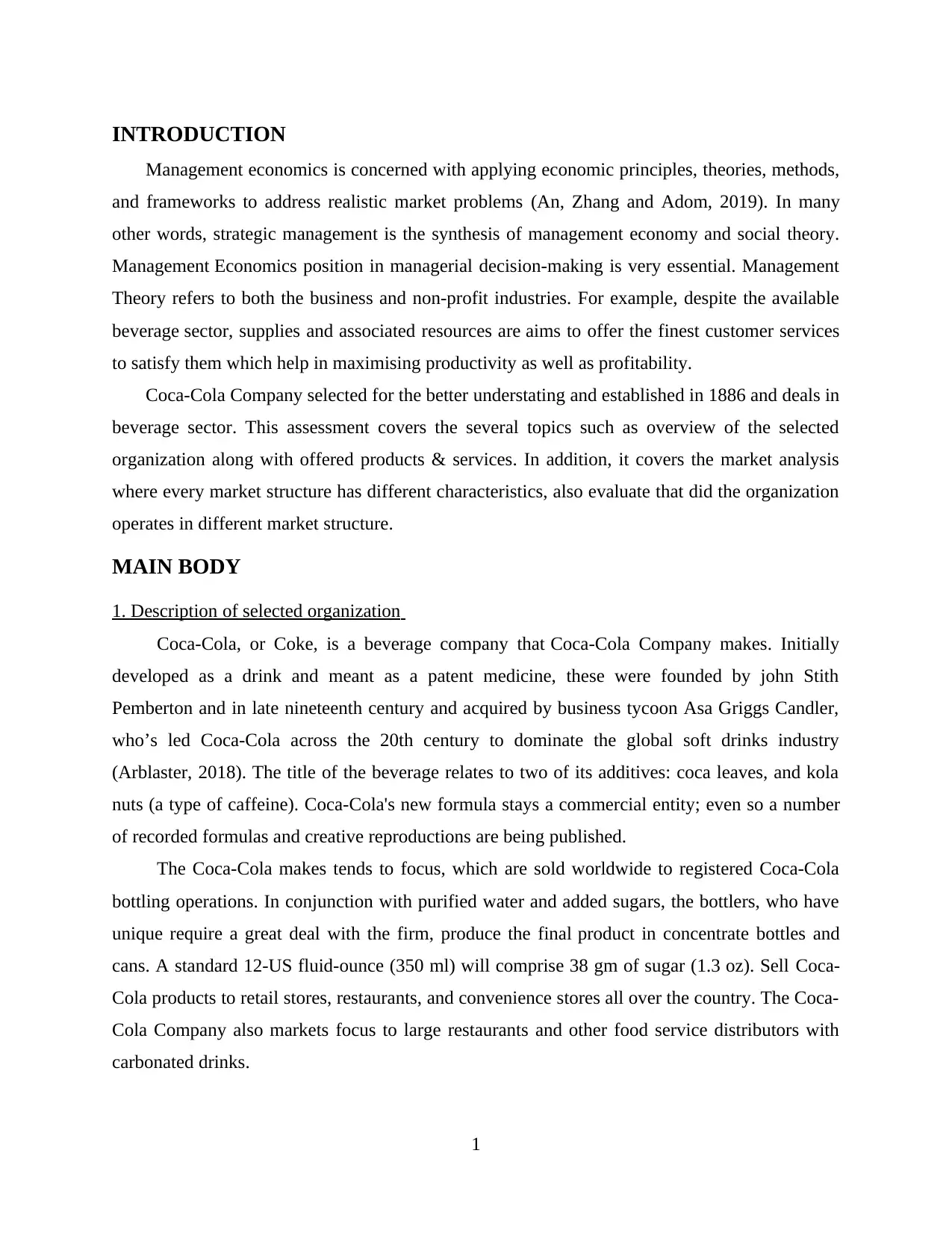
INTRODUCTION
Management economics is concerned with applying economic principles, theories, methods,
and frameworks to address realistic market problems (An, Zhang and Adom, 2019). In many
other words, strategic management is the synthesis of management economy and social theory.
Management Economics position in managerial decision-making is very essential. Management
Theory refers to both the business and non-profit industries. For example, despite the available
beverage sector, supplies and associated resources are aims to offer the finest customer services
to satisfy them which help in maximising productivity as well as profitability.
Coca-Cola Company selected for the better understating and established in 1886 and deals in
beverage sector. This assessment covers the several topics such as overview of the selected
organization along with offered products & services. In addition, it covers the market analysis
where every market structure has different characteristics, also evaluate that did the organization
operates in different market structure.
MAIN BODY
1. Description of selected organization
Coca-Cola, or Coke, is a beverage company that Coca-Cola Company makes. Initially
developed as a drink and meant as a patent medicine, these were founded by john Stith
Pemberton and in late nineteenth century and acquired by business tycoon Asa Griggs Candler,
who’s led Coca-Cola across the 20th century to dominate the global soft drinks industry
(Arblaster, 2018). The title of the beverage relates to two of its additives: coca leaves, and kola
nuts (a type of caffeine). Coca-Cola's new formula stays a commercial entity; even so a number
of recorded formulas and creative reproductions are being published.
The Coca-Cola makes tends to focus, which are sold worldwide to registered Coca-Cola
bottling operations. In conjunction with purified water and added sugars, the bottlers, who have
unique require a great deal with the firm, produce the final product in concentrate bottles and
cans. A standard 12-US fluid-ounce (350 ml) will comprise 38 gm of sugar (1.3 oz). Sell Coca-
Cola products to retail stores, restaurants, and convenience stores all over the country. The Coca-
Cola Company also markets focus to large restaurants and other food service distributors with
carbonated drinks.
1
Management economics is concerned with applying economic principles, theories, methods,
and frameworks to address realistic market problems (An, Zhang and Adom, 2019). In many
other words, strategic management is the synthesis of management economy and social theory.
Management Economics position in managerial decision-making is very essential. Management
Theory refers to both the business and non-profit industries. For example, despite the available
beverage sector, supplies and associated resources are aims to offer the finest customer services
to satisfy them which help in maximising productivity as well as profitability.
Coca-Cola Company selected for the better understating and established in 1886 and deals in
beverage sector. This assessment covers the several topics such as overview of the selected
organization along with offered products & services. In addition, it covers the market analysis
where every market structure has different characteristics, also evaluate that did the organization
operates in different market structure.
MAIN BODY
1. Description of selected organization
Coca-Cola, or Coke, is a beverage company that Coca-Cola Company makes. Initially
developed as a drink and meant as a patent medicine, these were founded by john Stith
Pemberton and in late nineteenth century and acquired by business tycoon Asa Griggs Candler,
who’s led Coca-Cola across the 20th century to dominate the global soft drinks industry
(Arblaster, 2018). The title of the beverage relates to two of its additives: coca leaves, and kola
nuts (a type of caffeine). Coca-Cola's new formula stays a commercial entity; even so a number
of recorded formulas and creative reproductions are being published.
The Coca-Cola makes tends to focus, which are sold worldwide to registered Coca-Cola
bottling operations. In conjunction with purified water and added sugars, the bottlers, who have
unique require a great deal with the firm, produce the final product in concentrate bottles and
cans. A standard 12-US fluid-ounce (350 ml) will comprise 38 gm of sugar (1.3 oz). Sell Coca-
Cola products to retail stores, restaurants, and convenience stores all over the country. The Coca-
Cola Company also markets focus to large restaurants and other food service distributors with
carbonated drinks.
1
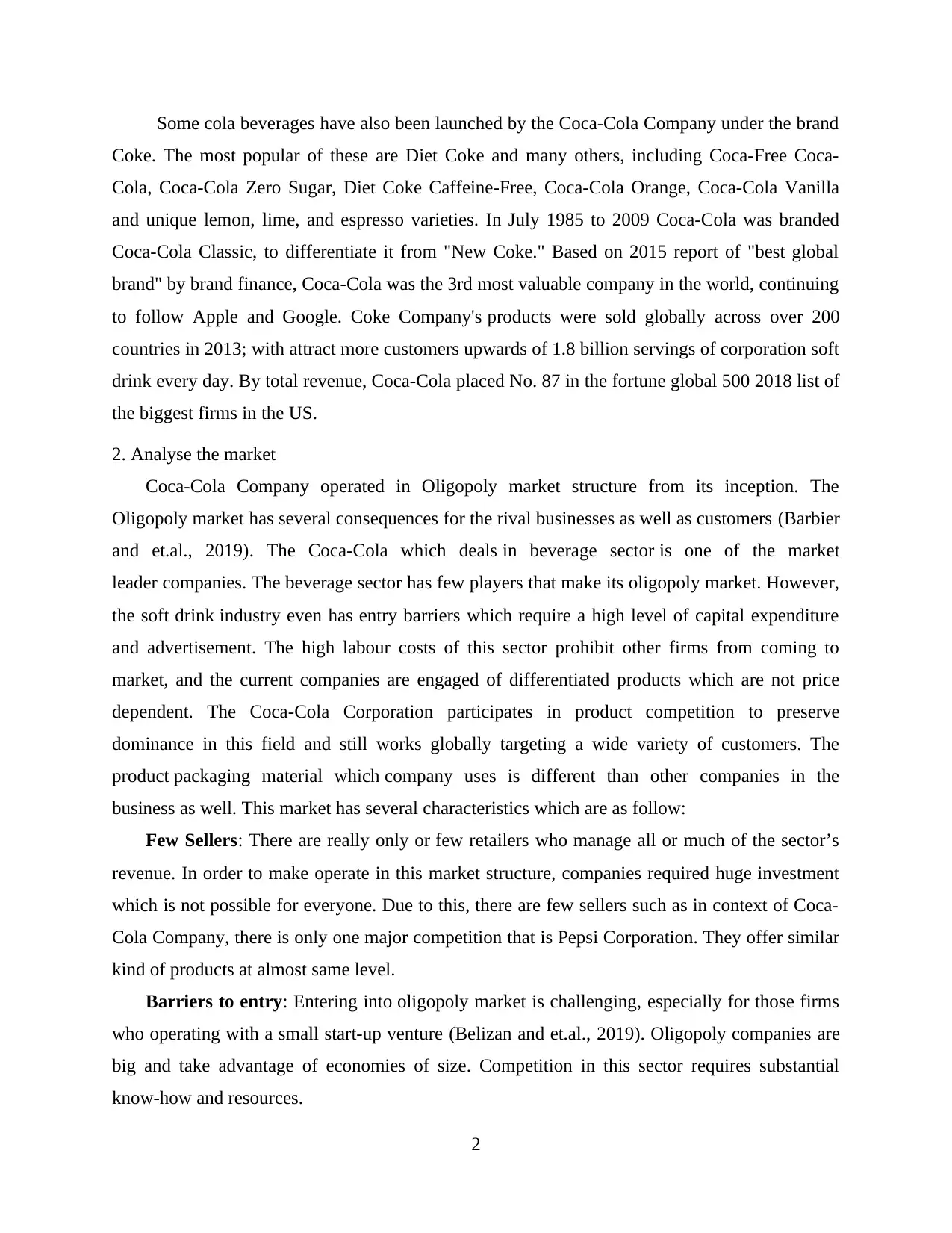
Some cola beverages have also been launched by the Coca-Cola Company under the brand
Coke. The most popular of these are Diet Coke and many others, including Coca-Free Coca-
Cola, Coca-Cola Zero Sugar, Diet Coke Caffeine-Free, Coca-Cola Orange, Coca-Cola Vanilla
and unique lemon, lime, and espresso varieties. In July 1985 to 2009 Coca-Cola was branded
Coca-Cola Classic, to differentiate it from "New Coke." Based on 2015 report of "best global
brand" by brand finance, Coca-Cola was the 3rd most valuable company in the world, continuing
to follow Apple and Google. Coke Company's products were sold globally across over 200
countries in 2013; with attract more customers upwards of 1.8 billion servings of corporation soft
drink every day. By total revenue, Coca-Cola placed No. 87 in the fortune global 500 2018 list of
the biggest firms in the US.
2. Analyse the market
Coca-Cola Company operated in Oligopoly market structure from its inception. The
Oligopoly market has several consequences for the rival businesses as well as customers (Barbier
and et.al., 2019). The Coca-Cola which deals in beverage sector is one of the market
leader companies. The beverage sector has few players that make its oligopoly market. However,
the soft drink industry even has entry barriers which require a high level of capital expenditure
and advertisement. The high labour costs of this sector prohibit other firms from coming to
market, and the current companies are engaged of differentiated products which are not price
dependent. The Coca-Cola Corporation participates in product competition to preserve
dominance in this field and still works globally targeting a wide variety of customers. The
product packaging material which company uses is different than other companies in the
business as well. This market has several characteristics which are as follow:
Few Sellers: There are really only or few retailers who manage all or much of the sector’s
revenue. In order to make operate in this market structure, companies required huge investment
which is not possible for everyone. Due to this, there are few sellers such as in context of Coca-
Cola Company, there is only one major competition that is Pepsi Corporation. They offer similar
kind of products at almost same level.
Barriers to entry: Entering into oligopoly market is challenging, especially for those firms
who operating with a small start-up venture (Belizan and et.al., 2019). Oligopoly companies are
big and take advantage of economies of size. Competition in this sector requires substantial
know-how and resources.
2
Coke. The most popular of these are Diet Coke and many others, including Coca-Free Coca-
Cola, Coca-Cola Zero Sugar, Diet Coke Caffeine-Free, Coca-Cola Orange, Coca-Cola Vanilla
and unique lemon, lime, and espresso varieties. In July 1985 to 2009 Coca-Cola was branded
Coca-Cola Classic, to differentiate it from "New Coke." Based on 2015 report of "best global
brand" by brand finance, Coca-Cola was the 3rd most valuable company in the world, continuing
to follow Apple and Google. Coke Company's products were sold globally across over 200
countries in 2013; with attract more customers upwards of 1.8 billion servings of corporation soft
drink every day. By total revenue, Coca-Cola placed No. 87 in the fortune global 500 2018 list of
the biggest firms in the US.
2. Analyse the market
Coca-Cola Company operated in Oligopoly market structure from its inception. The
Oligopoly market has several consequences for the rival businesses as well as customers (Barbier
and et.al., 2019). The Coca-Cola which deals in beverage sector is one of the market
leader companies. The beverage sector has few players that make its oligopoly market. However,
the soft drink industry even has entry barriers which require a high level of capital expenditure
and advertisement. The high labour costs of this sector prohibit other firms from coming to
market, and the current companies are engaged of differentiated products which are not price
dependent. The Coca-Cola Corporation participates in product competition to preserve
dominance in this field and still works globally targeting a wide variety of customers. The
product packaging material which company uses is different than other companies in the
business as well. This market has several characteristics which are as follow:
Few Sellers: There are really only or few retailers who manage all or much of the sector’s
revenue. In order to make operate in this market structure, companies required huge investment
which is not possible for everyone. Due to this, there are few sellers such as in context of Coca-
Cola Company, there is only one major competition that is Pepsi Corporation. They offer similar
kind of products at almost same level.
Barriers to entry: Entering into oligopoly market is challenging, especially for those firms
who operating with a small start-up venture (Belizan and et.al., 2019). Oligopoly companies are
big and take advantage of economies of size. Competition in this sector requires substantial
know-how and resources.
2
Secure Best Marks with AI Grader
Need help grading? Try our AI Grader for instant feedback on your assignments.
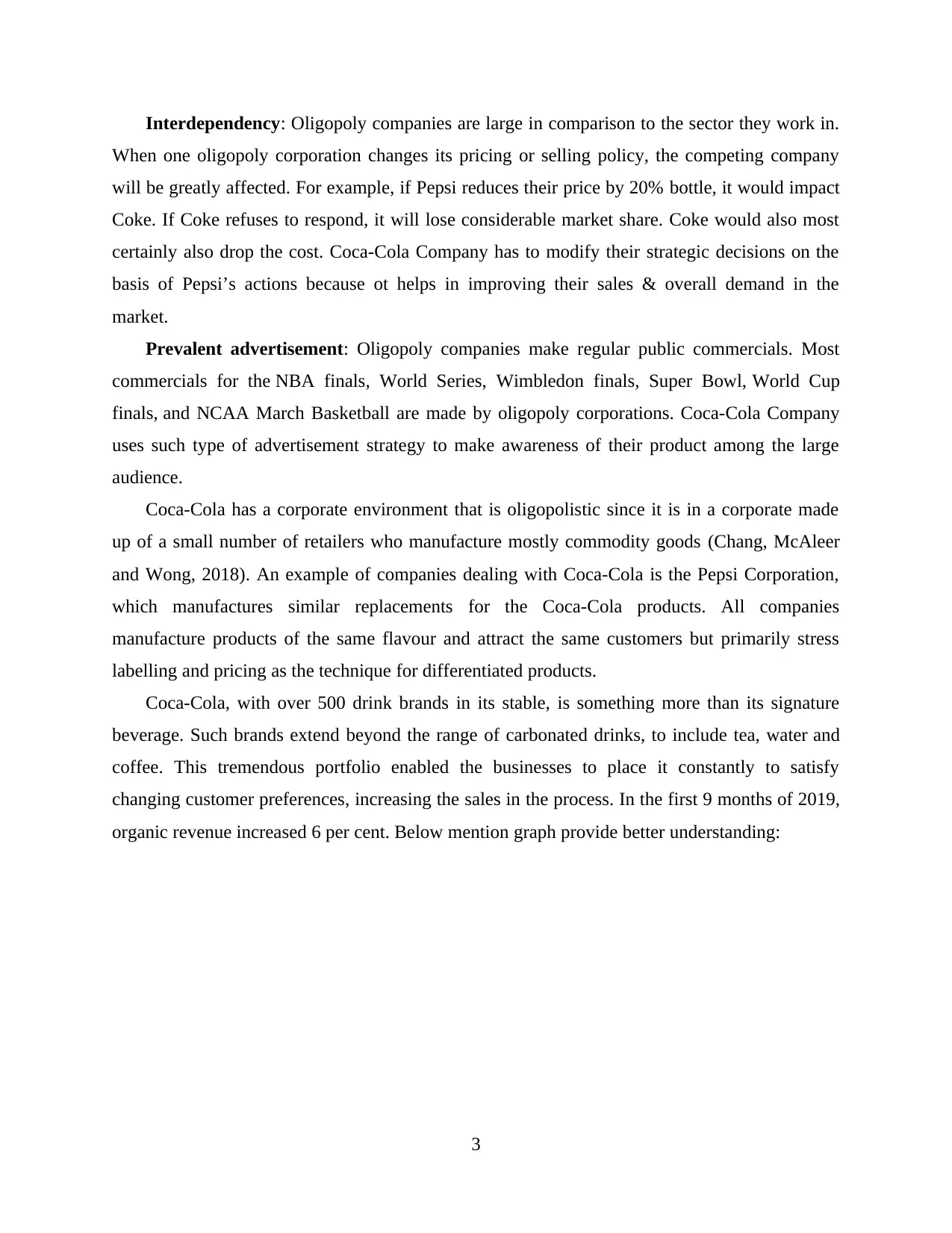
Interdependency: Oligopoly companies are large in comparison to the sector they work in.
When one oligopoly corporation changes its pricing or selling policy, the competing company
will be greatly affected. For example, if Pepsi reduces their price by 20% bottle, it would impact
Coke. If Coke refuses to respond, it will lose considerable market share. Coke would also most
certainly also drop the cost. Coca-Cola Company has to modify their strategic decisions on the
basis of Pepsi’s actions because ot helps in improving their sales & overall demand in the
market.
Prevalent advertisement: Oligopoly companies make regular public commercials. Most
commercials for the NBA finals, World Series, Wimbledon finals, Super Bowl, World Cup
finals, and NCAA March Basketball are made by oligopoly corporations. Coca-Cola Company
uses such type of advertisement strategy to make awareness of their product among the large
audience.
Coca-Cola has a corporate environment that is oligopolistic since it is in a corporate made
up of a small number of retailers who manufacture mostly commodity goods (Chang, McAleer
and Wong, 2018). An example of companies dealing with Coca-Cola is the Pepsi Corporation,
which manufactures similar replacements for the Coca-Cola products. All companies
manufacture products of the same flavour and attract the same customers but primarily stress
labelling and pricing as the technique for differentiated products.
Coca-Cola, with over 500 drink brands in its stable, is something more than its signature
beverage. Such brands extend beyond the range of carbonated drinks, to include tea, water and
coffee. This tremendous portfolio enabled the businesses to place it constantly to satisfy
changing customer preferences, increasing the sales in the process. In the first 9 months of 2019,
organic revenue increased 6 per cent. Below mention graph provide better understanding:
3
When one oligopoly corporation changes its pricing or selling policy, the competing company
will be greatly affected. For example, if Pepsi reduces their price by 20% bottle, it would impact
Coke. If Coke refuses to respond, it will lose considerable market share. Coke would also most
certainly also drop the cost. Coca-Cola Company has to modify their strategic decisions on the
basis of Pepsi’s actions because ot helps in improving their sales & overall demand in the
market.
Prevalent advertisement: Oligopoly companies make regular public commercials. Most
commercials for the NBA finals, World Series, Wimbledon finals, Super Bowl, World Cup
finals, and NCAA March Basketball are made by oligopoly corporations. Coca-Cola Company
uses such type of advertisement strategy to make awareness of their product among the large
audience.
Coca-Cola has a corporate environment that is oligopolistic since it is in a corporate made
up of a small number of retailers who manufacture mostly commodity goods (Chang, McAleer
and Wong, 2018). An example of companies dealing with Coca-Cola is the Pepsi Corporation,
which manufactures similar replacements for the Coca-Cola products. All companies
manufacture products of the same flavour and attract the same customers but primarily stress
labelling and pricing as the technique for differentiated products.
Coca-Cola, with over 500 drink brands in its stable, is something more than its signature
beverage. Such brands extend beyond the range of carbonated drinks, to include tea, water and
coffee. This tremendous portfolio enabled the businesses to place it constantly to satisfy
changing customer preferences, increasing the sales in the process. In the first 9 months of 2019,
organic revenue increased 6 per cent. Below mention graph provide better understanding:
3
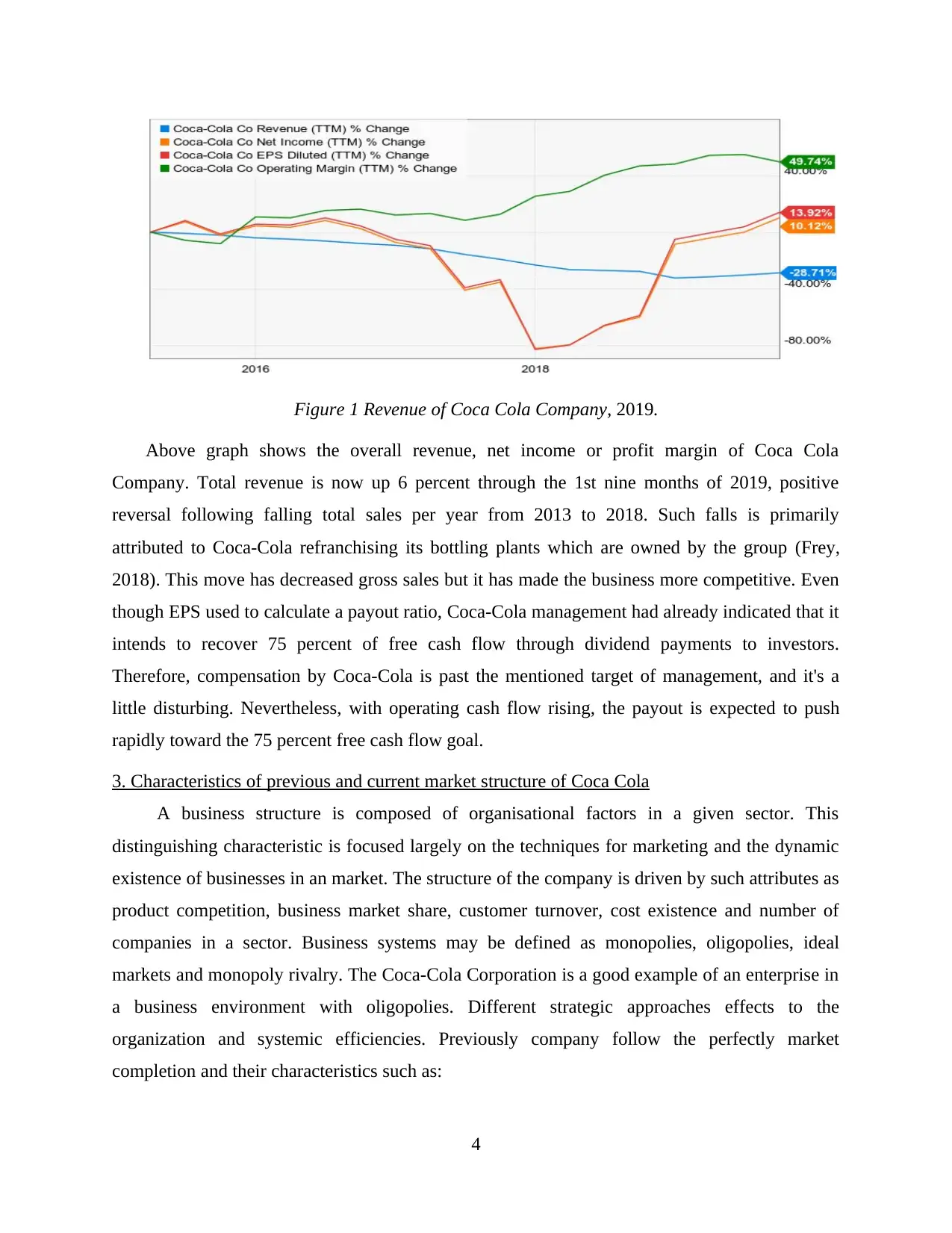
Figure 1 Revenue of Coca Cola Company, 2019.
Above graph shows the overall revenue, net income or profit margin of Coca Cola
Company. Total revenue is now up 6 percent through the 1st nine months of 2019, positive
reversal following falling total sales per year from 2013 to 2018. Such falls is primarily
attributed to Coca-Cola refranchising its bottling plants which are owned by the group (Frey,
2018). This move has decreased gross sales but it has made the business more competitive. Even
though EPS used to calculate a payout ratio, Coca-Cola management had already indicated that it
intends to recover 75 percent of free cash flow through dividend payments to investors.
Therefore, compensation by Coca-Cola is past the mentioned target of management, and it's a
little disturbing. Nevertheless, with operating cash flow rising, the payout is expected to push
rapidly toward the 75 percent free cash flow goal.
3. Characteristics of previous and current market structure of Coca Cola
A business structure is composed of organisational factors in a given sector. This
distinguishing characteristic is focused largely on the techniques for marketing and the dynamic
existence of businesses in an market. The structure of the company is driven by such attributes as
product competition, business market share, customer turnover, cost existence and number of
companies in a sector. Business systems may be defined as monopolies, oligopolies, ideal
markets and monopoly rivalry. The Coca-Cola Corporation is a good example of an enterprise in
a business environment with oligopolies. Different strategic approaches effects to the
organization and systemic efficiencies. Previously company follow the perfectly market
completion and their characteristics such as:
4
Above graph shows the overall revenue, net income or profit margin of Coca Cola
Company. Total revenue is now up 6 percent through the 1st nine months of 2019, positive
reversal following falling total sales per year from 2013 to 2018. Such falls is primarily
attributed to Coca-Cola refranchising its bottling plants which are owned by the group (Frey,
2018). This move has decreased gross sales but it has made the business more competitive. Even
though EPS used to calculate a payout ratio, Coca-Cola management had already indicated that it
intends to recover 75 percent of free cash flow through dividend payments to investors.
Therefore, compensation by Coca-Cola is past the mentioned target of management, and it's a
little disturbing. Nevertheless, with operating cash flow rising, the payout is expected to push
rapidly toward the 75 percent free cash flow goal.
3. Characteristics of previous and current market structure of Coca Cola
A business structure is composed of organisational factors in a given sector. This
distinguishing characteristic is focused largely on the techniques for marketing and the dynamic
existence of businesses in an market. The structure of the company is driven by such attributes as
product competition, business market share, customer turnover, cost existence and number of
companies in a sector. Business systems may be defined as monopolies, oligopolies, ideal
markets and monopoly rivalry. The Coca-Cola Corporation is a good example of an enterprise in
a business environment with oligopolies. Different strategic approaches effects to the
organization and systemic efficiencies. Previously company follow the perfectly market
completion and their characteristics such as:
4
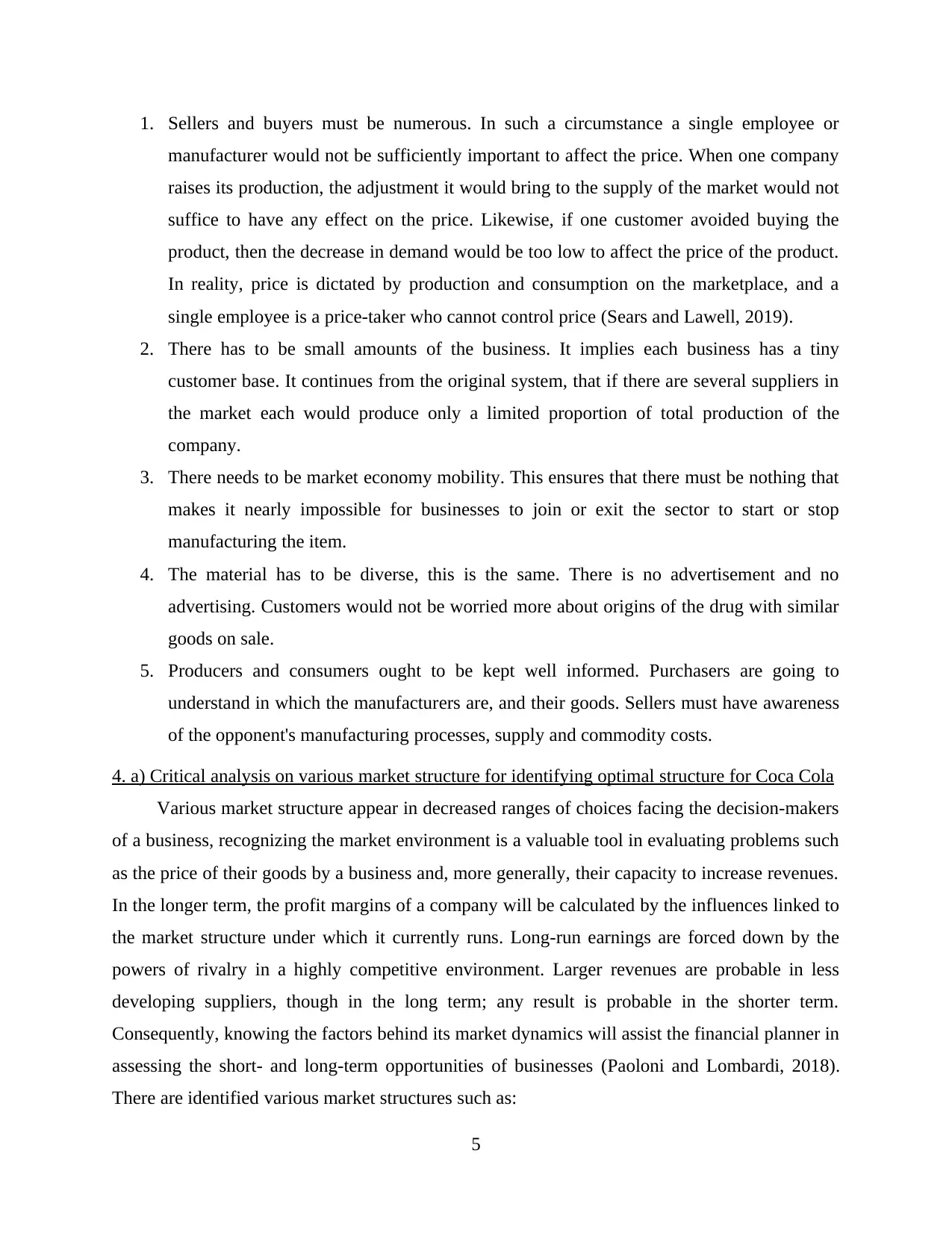
1. Sellers and buyers must be numerous. In such a circumstance a single employee or
manufacturer would not be sufficiently important to affect the price. When one company
raises its production, the adjustment it would bring to the supply of the market would not
suffice to have any effect on the price. Likewise, if one customer avoided buying the
product, then the decrease in demand would be too low to affect the price of the product.
In reality, price is dictated by production and consumption on the marketplace, and a
single employee is a price-taker who cannot control price (Sears and Lawell, 2019).
2. There has to be small amounts of the business. It implies each business has a tiny
customer base. It continues from the original system, that if there are several suppliers in
the market each would produce only a limited proportion of total production of the
company.
3. There needs to be market economy mobility. This ensures that there must be nothing that
makes it nearly impossible for businesses to join or exit the sector to start or stop
manufacturing the item.
4. The material has to be diverse, this is the same. There is no advertisement and no
advertising. Customers would not be worried more about origins of the drug with similar
goods on sale.
5. Producers and consumers ought to be kept well informed. Purchasers are going to
understand in which the manufacturers are, and their goods. Sellers must have awareness
of the opponent's manufacturing processes, supply and commodity costs.
4. a) Critical analysis on various market structure for identifying optimal structure for Coca Cola
Various market structure appear in decreased ranges of choices facing the decision-makers
of a business, recognizing the market environment is a valuable tool in evaluating problems such
as the price of their goods by a business and, more generally, their capacity to increase revenues.
In the longer term, the profit margins of a company will be calculated by the influences linked to
the market structure under which it currently runs. Long-run earnings are forced down by the
powers of rivalry in a highly competitive environment. Larger revenues are probable in less
developing suppliers, though in the long term; any result is probable in the shorter term.
Consequently, knowing the factors behind its market dynamics will assist the financial planner in
assessing the short- and long-term opportunities of businesses (Paoloni and Lombardi, 2018).
There are identified various market structures such as:
5
manufacturer would not be sufficiently important to affect the price. When one company
raises its production, the adjustment it would bring to the supply of the market would not
suffice to have any effect on the price. Likewise, if one customer avoided buying the
product, then the decrease in demand would be too low to affect the price of the product.
In reality, price is dictated by production and consumption on the marketplace, and a
single employee is a price-taker who cannot control price (Sears and Lawell, 2019).
2. There has to be small amounts of the business. It implies each business has a tiny
customer base. It continues from the original system, that if there are several suppliers in
the market each would produce only a limited proportion of total production of the
company.
3. There needs to be market economy mobility. This ensures that there must be nothing that
makes it nearly impossible for businesses to join or exit the sector to start or stop
manufacturing the item.
4. The material has to be diverse, this is the same. There is no advertisement and no
advertising. Customers would not be worried more about origins of the drug with similar
goods on sale.
5. Producers and consumers ought to be kept well informed. Purchasers are going to
understand in which the manufacturers are, and their goods. Sellers must have awareness
of the opponent's manufacturing processes, supply and commodity costs.
4. a) Critical analysis on various market structure for identifying optimal structure for Coca Cola
Various market structure appear in decreased ranges of choices facing the decision-makers
of a business, recognizing the market environment is a valuable tool in evaluating problems such
as the price of their goods by a business and, more generally, their capacity to increase revenues.
In the longer term, the profit margins of a company will be calculated by the influences linked to
the market structure under which it currently runs. Long-run earnings are forced down by the
powers of rivalry in a highly competitive environment. Larger revenues are probable in less
developing suppliers, though in the long term; any result is probable in the shorter term.
Consequently, knowing the factors behind its market dynamics will assist the financial planner in
assessing the short- and long-term opportunities of businesses (Paoloni and Lombardi, 2018).
There are identified various market structures such as:
5
Paraphrase This Document
Need a fresh take? Get an instant paraphrase of this document with our AI Paraphraser
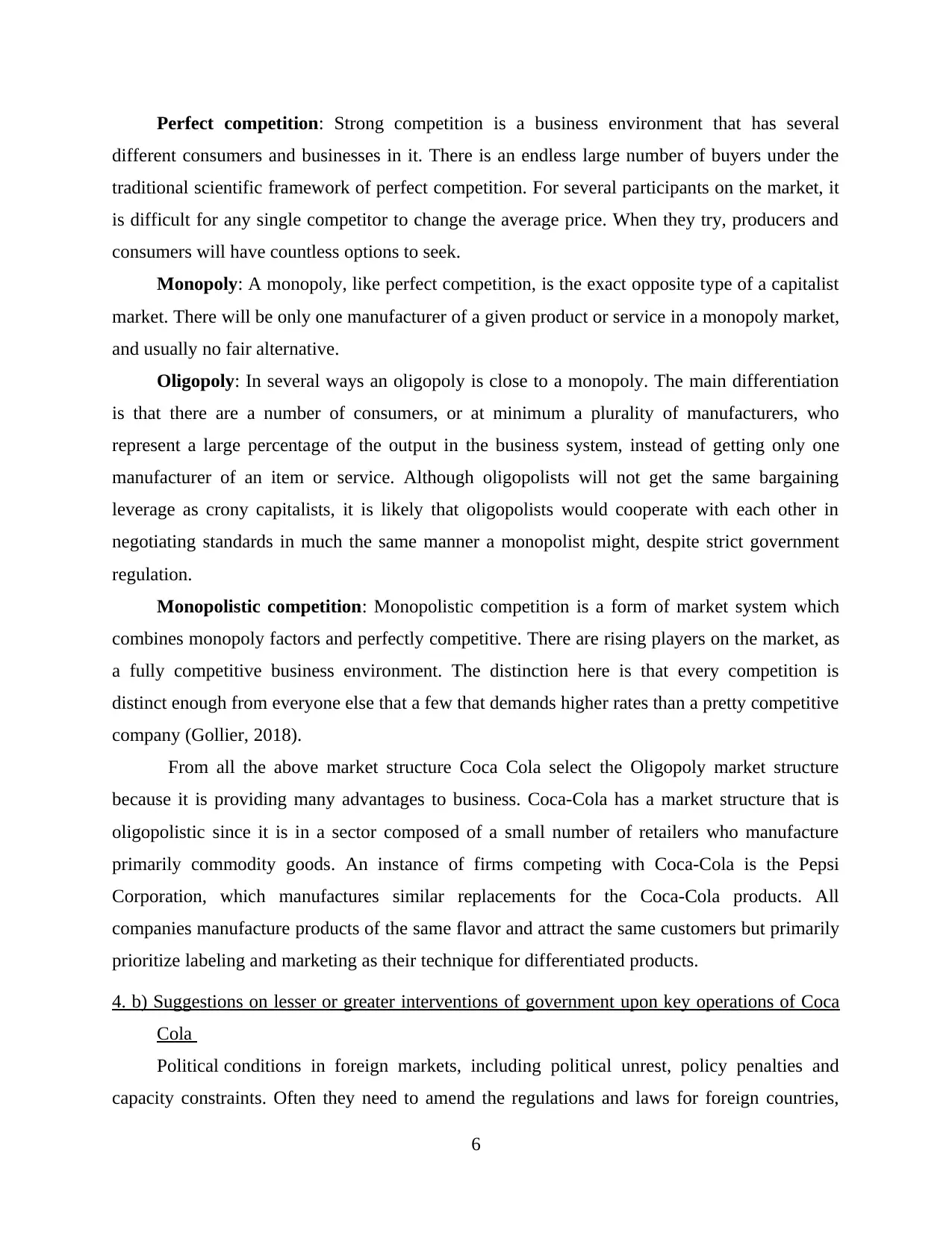
Perfect competition: Strong competition is a business environment that has several
different consumers and businesses in it. There is an endless large number of buyers under the
traditional scientific framework of perfect competition. For several participants on the market, it
is difficult for any single competitor to change the average price. When they try, producers and
consumers will have countless options to seek.
Monopoly: A monopoly, like perfect competition, is the exact opposite type of a capitalist
market. There will be only one manufacturer of a given product or service in a monopoly market,
and usually no fair alternative.
Oligopoly: In several ways an oligopoly is close to a monopoly. The main differentiation
is that there are a number of consumers, or at minimum a plurality of manufacturers, who
represent a large percentage of the output in the business system, instead of getting only one
manufacturer of an item or service. Although oligopolists will not get the same bargaining
leverage as crony capitalists, it is likely that oligopolists would cooperate with each other in
negotiating standards in much the same manner a monopolist might, despite strict government
regulation.
Monopolistic competition: Monopolistic competition is a form of market system which
combines monopoly factors and perfectly competitive. There are rising players on the market, as
a fully competitive business environment. The distinction here is that every competition is
distinct enough from everyone else that a few that demands higher rates than a pretty competitive
company (Gollier, 2018).
From all the above market structure Coca Cola select the Oligopoly market structure
because it is providing many advantages to business. Coca-Cola has a market structure that is
oligopolistic since it is in a sector composed of a small number of retailers who manufacture
primarily commodity goods. An instance of firms competing with Coca-Cola is the Pepsi
Corporation, which manufactures similar replacements for the Coca-Cola products. All
companies manufacture products of the same flavor and attract the same customers but primarily
prioritize labeling and marketing as their technique for differentiated products.
4. b) Suggestions on lesser or greater interventions of government upon key operations of Coca
Cola
Political conditions in foreign markets, including political unrest, policy penalties and
capacity constraints. Often they need to amend the regulations and laws for foreign countries,
6
different consumers and businesses in it. There is an endless large number of buyers under the
traditional scientific framework of perfect competition. For several participants on the market, it
is difficult for any single competitor to change the average price. When they try, producers and
consumers will have countless options to seek.
Monopoly: A monopoly, like perfect competition, is the exact opposite type of a capitalist
market. There will be only one manufacturer of a given product or service in a monopoly market,
and usually no fair alternative.
Oligopoly: In several ways an oligopoly is close to a monopoly. The main differentiation
is that there are a number of consumers, or at minimum a plurality of manufacturers, who
represent a large percentage of the output in the business system, instead of getting only one
manufacturer of an item or service. Although oligopolists will not get the same bargaining
leverage as crony capitalists, it is likely that oligopolists would cooperate with each other in
negotiating standards in much the same manner a monopolist might, despite strict government
regulation.
Monopolistic competition: Monopolistic competition is a form of market system which
combines monopoly factors and perfectly competitive. There are rising players on the market, as
a fully competitive business environment. The distinction here is that every competition is
distinct enough from everyone else that a few that demands higher rates than a pretty competitive
company (Gollier, 2018).
From all the above market structure Coca Cola select the Oligopoly market structure
because it is providing many advantages to business. Coca-Cola has a market structure that is
oligopolistic since it is in a sector composed of a small number of retailers who manufacture
primarily commodity goods. An instance of firms competing with Coca-Cola is the Pepsi
Corporation, which manufactures similar replacements for the Coca-Cola products. All
companies manufacture products of the same flavor and attract the same customers but primarily
prioritize labeling and marketing as their technique for differentiated products.
4. b) Suggestions on lesser or greater interventions of government upon key operations of Coca
Cola
Political conditions in foreign markets, including political unrest, policy penalties and
capacity constraints. Often they need to amend the regulations and laws for foreign countries,
6
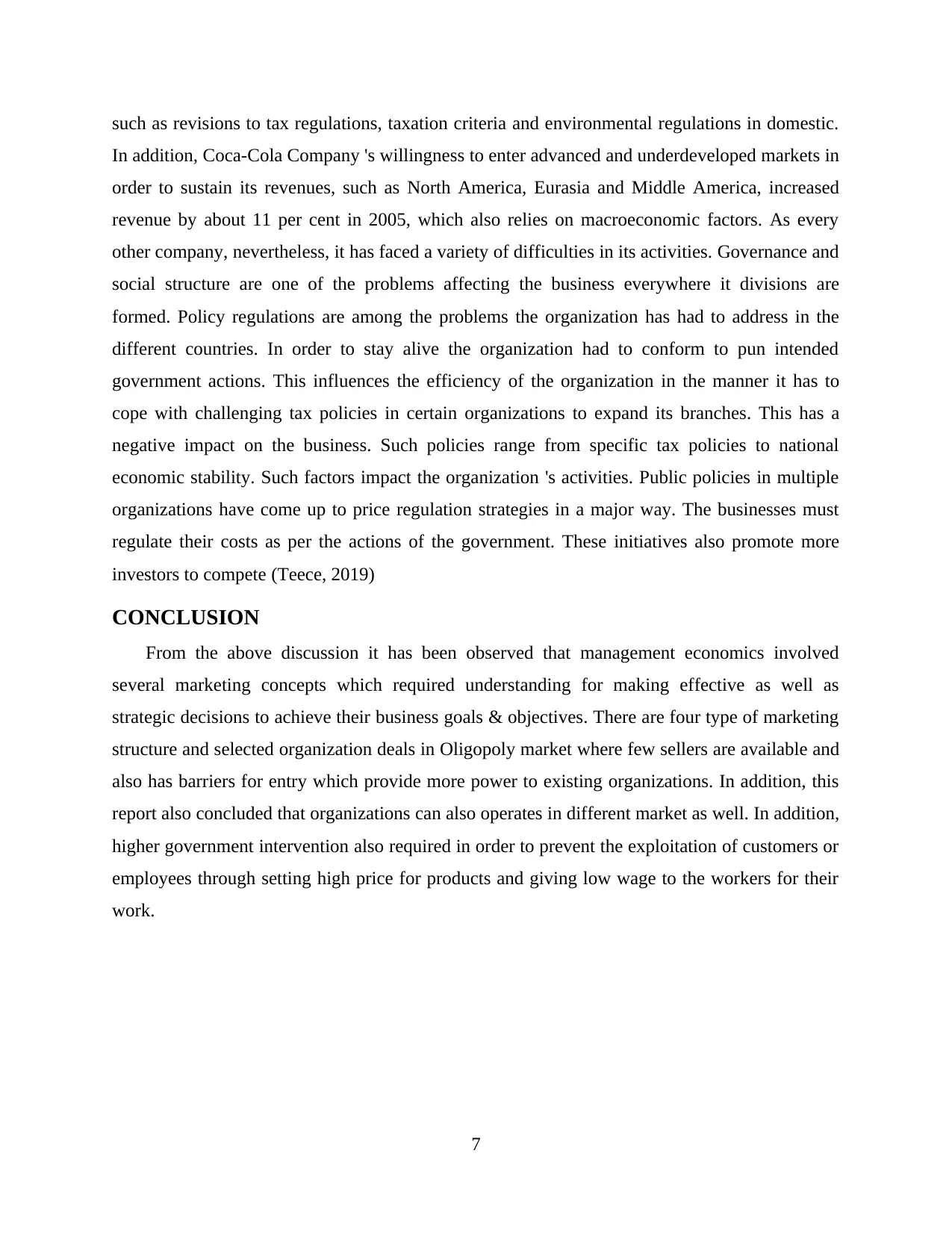
such as revisions to tax regulations, taxation criteria and environmental regulations in domestic.
In addition, Coca-Cola Company 's willingness to enter advanced and underdeveloped markets in
order to sustain its revenues, such as North America, Eurasia and Middle America, increased
revenue by about 11 per cent in 2005, which also relies on macroeconomic factors. As every
other company, nevertheless, it has faced a variety of difficulties in its activities. Governance and
social structure are one of the problems affecting the business everywhere it divisions are
formed. Policy regulations are among the problems the organization has had to address in the
different countries. In order to stay alive the organization had to conform to pun intended
government actions. This influences the efficiency of the organization in the manner it has to
cope with challenging tax policies in certain organizations to expand its branches. This has a
negative impact on the business. Such policies range from specific tax policies to national
economic stability. Such factors impact the organization 's activities. Public policies in multiple
organizations have come up to price regulation strategies in a major way. The businesses must
regulate their costs as per the actions of the government. These initiatives also promote more
investors to compete (Teece, 2019)
CONCLUSION
From the above discussion it has been observed that management economics involved
several marketing concepts which required understanding for making effective as well as
strategic decisions to achieve their business goals & objectives. There are four type of marketing
structure and selected organization deals in Oligopoly market where few sellers are available and
also has barriers for entry which provide more power to existing organizations. In addition, this
report also concluded that organizations can also operates in different market as well. In addition,
higher government intervention also required in order to prevent the exploitation of customers or
employees through setting high price for products and giving low wage to the workers for their
work.
7
In addition, Coca-Cola Company 's willingness to enter advanced and underdeveloped markets in
order to sustain its revenues, such as North America, Eurasia and Middle America, increased
revenue by about 11 per cent in 2005, which also relies on macroeconomic factors. As every
other company, nevertheless, it has faced a variety of difficulties in its activities. Governance and
social structure are one of the problems affecting the business everywhere it divisions are
formed. Policy regulations are among the problems the organization has had to address in the
different countries. In order to stay alive the organization had to conform to pun intended
government actions. This influences the efficiency of the organization in the manner it has to
cope with challenging tax policies in certain organizations to expand its branches. This has a
negative impact on the business. Such policies range from specific tax policies to national
economic stability. Such factors impact the organization 's activities. Public policies in multiple
organizations have come up to price regulation strategies in a major way. The businesses must
regulate their costs as per the actions of the government. These initiatives also promote more
investors to compete (Teece, 2019)
CONCLUSION
From the above discussion it has been observed that management economics involved
several marketing concepts which required understanding for making effective as well as
strategic decisions to achieve their business goals & objectives. There are four type of marketing
structure and selected organization deals in Oligopoly market where few sellers are available and
also has barriers for entry which provide more power to existing organizations. In addition, this
report also concluded that organizations can also operates in different market as well. In addition,
higher government intervention also required in order to prevent the exploitation of customers or
employees through setting high price for products and giving low wage to the workers for their
work.
7
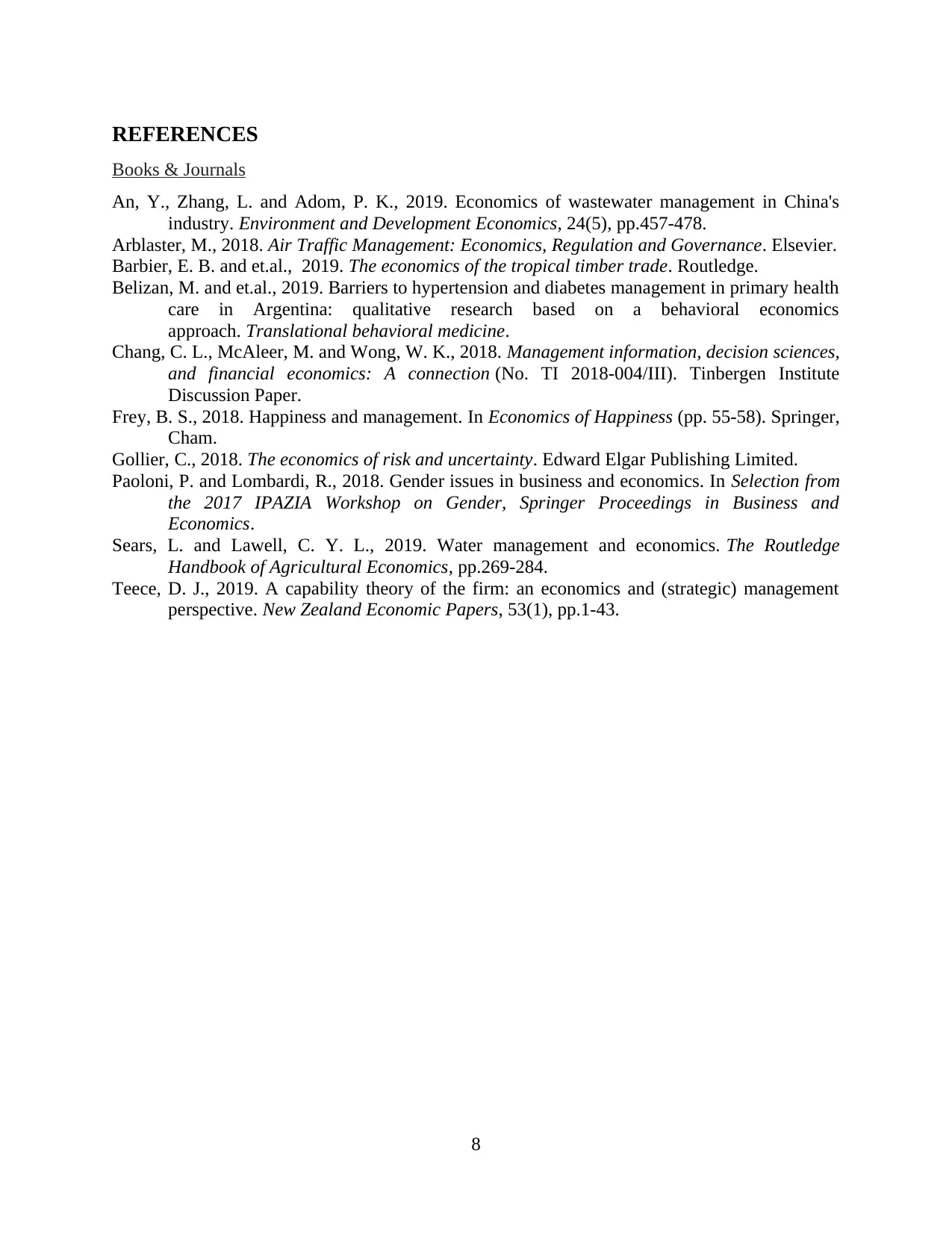
REFERENCES
Books & Journals
An, Y., Zhang, L. and Adom, P. K., 2019. Economics of wastewater management in China's
industry. Environment and Development Economics, 24(5), pp.457-478.
Arblaster, M., 2018. Air Traffic Management: Economics, Regulation and Governance. Elsevier.
Barbier, E. B. and et.al., 2019. The economics of the tropical timber trade. Routledge.
Belizan, M. and et.al., 2019. Barriers to hypertension and diabetes management in primary health
care in Argentina: qualitative research based on a behavioral economics
approach. Translational behavioral medicine.
Chang, C. L., McAleer, M. and Wong, W. K., 2018. Management information, decision sciences,
and financial economics: A connection (No. TI 2018-004/III). Tinbergen Institute
Discussion Paper.
Frey, B. S., 2018. Happiness and management. In Economics of Happiness (pp. 55-58). Springer,
Cham.
Gollier, C., 2018. The economics of risk and uncertainty. Edward Elgar Publishing Limited.
Paoloni, P. and Lombardi, R., 2018. Gender issues in business and economics. In Selection from
the 2017 IPAZIA Workshop on Gender, Springer Proceedings in Business and
Economics.
Sears, L. and Lawell, C. Y. L., 2019. Water management and economics. The Routledge
Handbook of Agricultural Economics, pp.269-284.
Teece, D. J., 2019. A capability theory of the firm: an economics and (strategic) management
perspective. New Zealand Economic Papers, 53(1), pp.1-43.
8
Books & Journals
An, Y., Zhang, L. and Adom, P. K., 2019. Economics of wastewater management in China's
industry. Environment and Development Economics, 24(5), pp.457-478.
Arblaster, M., 2018. Air Traffic Management: Economics, Regulation and Governance. Elsevier.
Barbier, E. B. and et.al., 2019. The economics of the tropical timber trade. Routledge.
Belizan, M. and et.al., 2019. Barriers to hypertension and diabetes management in primary health
care in Argentina: qualitative research based on a behavioral economics
approach. Translational behavioral medicine.
Chang, C. L., McAleer, M. and Wong, W. K., 2018. Management information, decision sciences,
and financial economics: A connection (No. TI 2018-004/III). Tinbergen Institute
Discussion Paper.
Frey, B. S., 2018. Happiness and management. In Economics of Happiness (pp. 55-58). Springer,
Cham.
Gollier, C., 2018. The economics of risk and uncertainty. Edward Elgar Publishing Limited.
Paoloni, P. and Lombardi, R., 2018. Gender issues in business and economics. In Selection from
the 2017 IPAZIA Workshop on Gender, Springer Proceedings in Business and
Economics.
Sears, L. and Lawell, C. Y. L., 2019. Water management and economics. The Routledge
Handbook of Agricultural Economics, pp.269-284.
Teece, D. J., 2019. A capability theory of the firm: an economics and (strategic) management
perspective. New Zealand Economic Papers, 53(1), pp.1-43.
8
1 out of 10
Related Documents
Your All-in-One AI-Powered Toolkit for Academic Success.
+13062052269
info@desklib.com
Available 24*7 on WhatsApp / Email
![[object Object]](/_next/static/media/star-bottom.7253800d.svg)
Unlock your academic potential
© 2024 | Zucol Services PVT LTD | All rights reserved.





